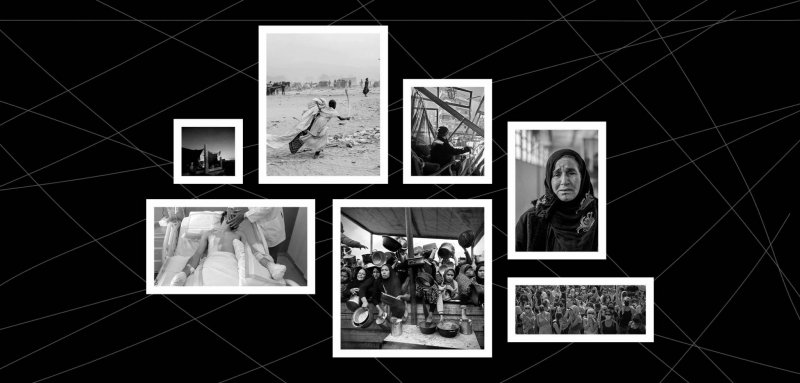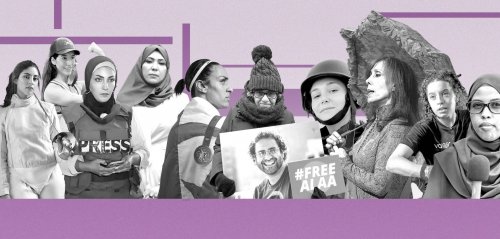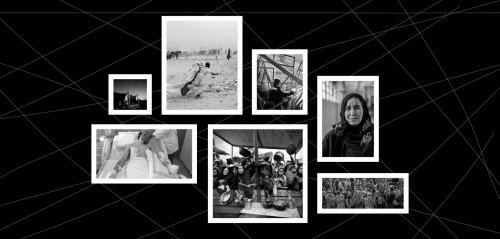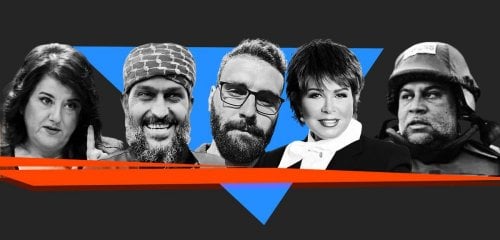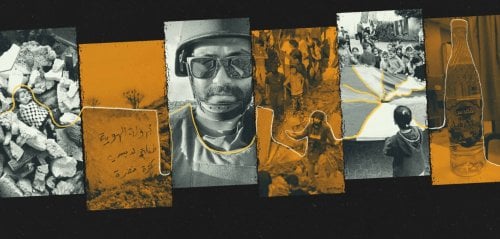The task of selecting a limited set of images to summarize the past year was not easy. The people of the Arab region endured numerous hardships, but, on a few occasions, they experienced moments of joy, triumph, and celebration.
With Gaza and Lebanon under the boot of the Israeli killing machine and the raging war in Sudan dominating the landscape, painful images were abundant throughout 2024. However, we did not want to neglect the inspiring moments of solidarity and support, as recent developments in Syria offered a glimmer of hope as the year came to a close.
1) Hunger in Gaza
A single image—or dozens—cannot capture or convey the full reality of an entire year living through the Israeli genocide in Gaza. No photo can adequately express the hunger, the continuous killings, the relentless bombings, the fear, the scattered limbs, the corpses strewn on the streets with no one left to bury them, the people buried underneath their homes, and the wounded who were left untreated. Nor can they fully express parents' inability to protect or heal their children, the torture and humiliation endured as residents walked, often stripped, between rows of Israeli soldiers, and the suffocating siege that starved millions.

These tragic conditions led multiple UN agencies to describe Gaza as a “graveyard” where “every path that one could possibly take leads to death.” Some have even labeled the besieged enclave as home to "two million starving people.” Israel killed over 45,000 people in the Gaza Strip, including approximately 15,000 children, while thousands remain missing and tens of thousands are permanently maimed, disabled, and injured.
No single image can capture or convey the reality of an entire year of genocide in Gaza. But this particular scene carries the most brutal aspects of the genocide—its darkness, the fire, displacement, mass graves, hunger, and helplessness.
2) The return of the Lebanese people to their homes

A 72-year-old Lebanese man returns to his home that was destroyed by Israel in the southern suburbs of Beirut following the ceasefire.
As soon as the ceasefire agreement was announced in Lebanon, effective from the early hours of November 27, 2024, thousands of displaced people rushed to return to their villages and towns at dawn, despite the continued warnings against returning as the Israeli forces had not fully withdrawn. This also came amid uncertainty over whether the terms of the agreement would hold or if their homes were still safe—many of which had either become uninhabitable or were completely destroyed.
Convoys of cars driving returnees to villages in South Lebanon and the Bekaa in the East were seen, packed with their luggage and belongings. Families and loved ones celebrated, their faces filled with joy, and tears of happiness were shed. Lebanese flags—and Hezbollah flags—were raised, with many flashing the symbol of victory. Above all, there was visible determination among residents to reconstruct their towns and rebuild their homes that were destroyed by the brutal Israeli aggression, which escalated on September 23, 2024, and continued for two months, killing over four thousand.

The return of displaced Lebanese people to their homes.
3) Life in Gaza
Journalist Mohammed Salem, who works in Gaza for Reuters, captured the essence of life in Gaza throughout 2024.

Life in Gaza, in a single image.
Salem captioned the photo: "Displaced Palestinians light a fire next to their tent while living at a cemetery in Khan Younis, in the southern Gaza Strip. October 27, 2024."
The image also shows a woman tending to the dying flames of their fire, hoping it will bring some warmth to the cold, dark night. A child is still awake despite the late time—perhaps from hunger, the cold, or the deafening sound of the overhead bombardment, with the glow of explosions flickering on the horizon.
4) Solidarity with Palestinians in the West
Amid the international community’s failure and inability to act on any meaningful effort to stop Israel’s relentless genocide in Gaza—which has been ongoing since October 7, 2023—popular displays of solidarity with Palestinians in Europe and the West were undoubtedly remarkable and, at times, inspiring. These included protests, silent vigils, university encampments, and demonstrations in front of Israeli businesses and institutions complicit in, or allied with, Israel.
However, the sit-ins by American university students calling for an end to Israel’s war on Gaza stood out as the most powerful and impactful.

Students at the most prestigious universities—institutions that have produced some of the world’s most formidable and influential politicians—staged sit-ins lasting for days and weeks. They demanded divestment and boycotts against Israel, undeterred by police assaults, threats of being deprived of jobs after graduation, or the risk of expulsion from their universities.
5) The horror of the pager explosions
In September 2024, Israel carried out an unprecedented operation to detonate hundreds of portable pagers and wireless communication devices used by Hezbollah members and their affiliates in Lebanon. The explosions, which took place in areas across Lebanon, evoked widespread horror and resulted in the murder of at least 42 civilians—including children—and injuring more than 3,000.
In the photo below, taken by French photographer William Daniels, one of the victims of the pager explosions in Lebanon is shown with severe injuries to his hands. The majority of injuries affected the eyes, hands, midsections, and legs. Ophthalmologists and orthopedic surgeons were faced with new and unexpected cases, conducting lengthy surgical procedures to extract pager fragments from the bodies of hundreds of wounded individuals.

6) The War in Sudan
The ongoing war in Sudan, which has lasted for nearly a year-and-a-half, has exacerbated the humanitarian crisis to horrific levels. Relief organizations operating in the country unanimously agree that girls and women are the most affected by the war, as they lack adequate shelter and food, and are subjected to the worst forms of violence and sexual exploitation, including enslavement for days and months. These documented violations implicate individuals on both sides of the conflict.

In the image above, a Sudanese refugee girl is seen carrying her belongings, wandering in search of shelter from the wind and impending rain at the Adré refugee camp in Chad. Surrounding the girl are other women who appear distressed by the worsening conditions. Some attempt to move using a cart pulled by an emaciated horse, which itself looks miserable due to a lack of food. In the background lies the vast, barren desert, devoid of any suitable living conditions or protection, with scattered garbage diminishing the environment’s suitability for living.
The savagery of Israeli soldiers in Gaza and Lebanon this year was not limited to killings, bombings, house demolitions, and the looting of property. They went further, violating privacy and engaging in cruel practices, including disturbing scenes of soldiers wearing women’s clothes and underwear and hanging dolls in children’s rooms.
7) Scenes of Israeli Soldiers Wearing Women's Clothes in Gaza and Lebanon

Israeli soldiers in the clothes of their victims
The brutality of Israeli soldiers in Gaza and Lebanon this year has not been limited to killings, bombings, house demolitions, and looting. They went further, violating privacy and engaging in cruel practices, including disturbing scenes of soldiers wearing women’s clothes, toying with their underwear, and displaying it around them, accompanied by offensive sexual remarks that reflect their contempt for Arab women.
Israeli soldiers carried out every form of savagery in Gaza and Lebanon, tampering with the property and possessions of killed or displaced residents, and desecrating their valuable and sentimental belongings. One soldier hung a teddy bear on his tank, while another "executed" a doll resembling a young girl in her room in Gaza.
8) The scene of detainees leaving Assad’s prisons

A Syrian mother from Qamishli stands inside one of Assad’s detention centers in Damascus, hoping to learn the fate of her four children.
The scenes of detainees and prisoners being released from the prisons and detention centers of Bashar al-Assad’s regime following his downfall and escape from the country reflected the cruelty and brutality of the fallen regime, as well as the suffering endured by its detainees. The sight of freed women emerging with their children, in particular, was shocking and painful.
A widely shared scene captured the attention of many – a child, perhaps no older than three, standing confused as armed Syrian opposition forces opened the cell doors, instructing the female detainees to exit and declaring the fall of the regime.
The child stood bewildered, perhaps having never left the cell before, unable to comprehend what was happening or what the men at the door were saying. This mixture of fear, joy, confusion, and anticipation for what was to come was felt by all those freed from Assad’s prisons.
In truth, it could be said that most Syrians shared this same sense of disbelief, much like the little boy and the detainees who hesitated to leave their cells, asking what the "state" might do to them if they left. One of the armed men replied: "There is no state anymore, sister."
9) Israel’s vicious bombing of South Lebanon

Israel drops internationally banned weapons in Lebanon.
This powerful image, taken by Leo Correa of the Associated Press (AP), captures the experiences of the Lebanese people, particularly in the South, during the Israeli aggression before a ceasefire agreement was reached at the end of November.
The intensity, concentration, and timing of the shelling—at night—reflect Zionism’s deep-seated hatred and insatiable desire for revenge, killing, and destruction.
Humanitarian organizations like Amnesty International, Human Rights Watch (HRW), and the UN Office for the Coordination of Humanitarian Affairs (OCHA) have repeatedly reported that “Israel is escalating its crimes against civilians and protected objects in Lebanon by using internationally prohibited weapons and highly-destructive bombs,” including white phosphorus since the start of its large-scale assault on people’s homes and villages across the country.
This photo was taken on September 30, 2024, when Israel’s ground forces first attempted to invade South Lebanon. Despite the ceasefire agreement coming into effect more than a month ago, Israeli forces continue to occupy border areas and villages. Southern towns and villages remain under attack and Israeli aggression, enduring ongoing bombings, demolitions, and even unjustified attacks on army and UNIFIL positions, with more than 401 ceasefire violations by Israel recorded to date.
The moment the statue of Hafez al-Assad was toppled in Arnous Square, in the heart of Damascus, was one of the defining moments of 2024. After it fell, dozens of Syrians stomped on it with their feet—perhaps as an act of revenge against the image of the statue that had been imposed on them day and night, despite all the hardship they had endured under his reign.
10) The toppling of Hafez al-Assad’s statue

The fall of Hafez al-Assad’s statue in Damascus
The moment the statue of Hafez al-Assad was toppled in Arnous Square, in the heart of Damascus, was one of the defining moments of 2024. After it fell, dozens of Syrians stomped on it with their feet—perhaps as an act of revenge against the image of the statue that had been imposed on them day and night, despite all the hardship they had endured under his reign.
Reflecting on this moment, our colleague, Syrian journalist Zina Shahla, wrote: “I felt a bit envious of those who brought down the statue of the late President Hafez al-Assad in Arnous Square in the early hours of the morning, as the sun was barely rising. I wished I could have taken part in this ‘operation.’ I have a personal vendetta against this massive statue—perhaps because of its extreme ugliness, always staring at us no matter where we turned our faces,” she recalled, reflecting on the moment when dozens of her friends and colleagues were arrested following a silent protest near the statue in 2011.
The fall of this statue carried far greater symbolism, signaling that the regime itself had “fallen.” And this time, “for good.”
Raseef22 is a not for profit entity. Our focus is on quality journalism. Every contribution to the NasRaseef membership goes directly towards journalism production. We stand independent, not accepting corporate sponsorships, sponsored content or political funding.
Support our mission to keep Raseef22 available to all readers by clicking here!
Interested in writing with us? Check our pitch process here!
